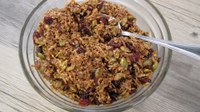Prairie Fare: Do You Know Anyone with a Peanut Allergy?
(Click an image below to view a high-resolution image that can be downloaded)
By Julie Garden-Robinson, Food and Nutrition Specialist, NDSU Extension
“We have someone with a severe peanut allergy on board, so peanut-containing snacks will not be served,” the flight attendant announced.
“Please refrain from eating any of your own snack foods with peanuts as an ingredient for the duration of the trip,” he continued.
I had packs of peanut butter crackers and peanuts in my purse waiting to be eaten. I did not have a chance to eat during my layover, so I was looking forward to a snack.
However, despite being a little hungry, I wasn’t about to put anyone’s life at risk for the sake of a few peanuts.
In fact, the flight was so turbulent that no snacks or beverages of any kind were served. The beverage cart was kept parked, and I watched a movie to keep my mind off of eating, drinking and the fact that I felt like I was on a roller coaster.
I enjoy peanuts in other situations. When I need a quick snack, I grab a few peanuts to tide me over.
Peanuts are an excellent source of protein and fiber, which help you feel full. They contain monounsaturated and polyunsaturated fats, which are heart healthy.
However, peanuts are among the foods most associated with allergic reactions, and the symptoms can range from mild to severe. Typically, some of the proteins naturally found in peanuts (arachin”and conarachin) are associated with their potential for allergic responses.
When a person with a food allergy is exposed to the allergen, the immune system takes action.
Peanuts are among the eight major food allergens. The remaining seven allergens are milk, eggs, tree nuts, wheat, soy, fish and shellfish.
For someone allergic to peanuts, mild symptoms may include hives, rash, itchy mouth, nausea, stomach pain, nasal congestion, sneezing and many others.
A severe allergy to peanuts may include swelling of the lips, tongue or throat; trouble swallowing; shortness of breath; feeling faint; loss of consciousness; chest pain; and/or weak pulse.
The worst-case scenario is anaphylaxis, when the allergy affects many areas of the body. The person may have tightened airways, a swollen throat, a severe drop in blood pressure, rapid pulse and/or loss of consciousness. Without prompt medical treatment, such as an injection of epinephrine, a peanut allergy can be fatal.
Even tiny amounts of the allergen through breathing or skin contact can lead to reactions.
According to the Food Allergy Research and Education (FARE) organization, 32 million people in the U.S. have food allergies. About one in 13 children (about two in every classroom) has some type of allergy.
Further, the FARE organization noted that childhood hospitalizations related to food allergy tripled from the late 1990s to the mid-2000s.
Those with a peanut allergy need to completely avoid peanuts or foods that may have come into contact with peanuts during the manufacture of foods. Just like cross-contamination in foods, some amounts of peanuts can be transferred from one food to another through contact with utensils, plates and other surfaces.
The federal Food Labeling Act requires that all packaged food products sold in the U.S. that contain peanuts must list the word “peanut” on the label. Look at the ingredient statement for the allergen statement, “Contains peanuts.”
Other foods, such as beer nuts, mixed nuts, peanut oil, nut meats, mandelonas and several other ingredients, need to be avoided by those with peanut allergies. Mandelonas are peanuts soaked in almond flavoring, by the way.
Although reading food labels is a good idea any time, reading is especially important if you have a food allergy. Remember, too, that ingredients in packaged food products may change without warning, so check ingredient statements every time you shop. If you have questions, call the manufacturer.
Visit https://www.ag.ndsu.edu/food to see other food allergy fact sheets. Here’s a peanut-free recipe to try.
7-Ingredient Chocolate Granola (Peanut-free)
1 1/2 c. unsweetened coconut flakes
1/2 c. pumpkin seeds
1/2 c. flaxseeds
1 Tbsp. Sunbutter or almond butter
1 Tbsp. canola oil
1/4 c. dried cranberries
1/4 c. semisweet chocolate chips
Sunbutter is a product made from sunflower seeds. When available, it typically is sold near peanut butter in the grocery store.
Mix together coconut flakes, pumpkin seeds and flaxseeds in a medium bowl; set aside. Heat a large skillet over medium heat, and add canola oil and Sunbutter or almond butter. Add the dry coconut flake/seed mixture to the skillet and stir well. Make sure dry ingredients are evenly coated with the butter mixture. Toast in the skillet for about 10 to 15 minutes on medium-low heat. Pour mixture onto a tray lined with parchment paper, and after a few minutes of cooling, add chocolate chips and dried cranberries, and toss to mix. Chips will continue melting to make the granola creamy and chocolatey. Enjoy with your favorite milk or yogurt, or by itself.
Makes 12 servings. Each serving has 160 calories, 12 g fat, 5 g protein, 11 g carbohydrate, 3 g fiber and 5 mg sodium.
(Julie Garden-Robinson, Ph.D., R.D., L.R.D., is a North Dakota State University Extension food and nutrition specialist and professor in the Department of Health, Nutrition and Exercise Sciences. Follow her on Twitter @jgardenrobinson)
NDSU Agriculture Communication – April 25, 2019
| Source: | Julie Garden-Robinson, 701-231-7187, julie.garden-robinson@ndsu.edu |
|---|---|
| Editor: | Becky Koch, 701-231-7875, becky.koch@ndsu.edu |



